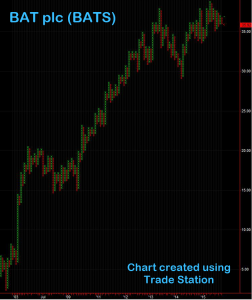British American Tobacco – The Future Is Lit Up

There is a smoking ban in public places in Beijing now. Not for the first time apparently. But this time they mean it. So now it’s no smoking at all, at all. Many are sceptical that this ban will work any better than the last attempts, which failed completely. And second-guessing the motivation of politicians is a fool’s errand. It’s almost invariably not what they say it is.
I remember going through Hong Kong transferring flights there on the way back from Australia. All the transfer passengers waited in a long corridor-like room, and I’ve not seen so much smoke since a friend of mine made a lot of holes in his old wardrobe, put a lit spliff in each of them and tried to smoke them all at once! Now of course there’s skunk for the discerning Mary Jane aficionado, the genetically modified plant that is seemingly Monsanto-haters’ GM crop of choice.
So with governments trying to reduce smoking, how does the future look for companies like BAT? Well the future is looking pretty good. Most of the developed world (where they still might actually lose a court battle for the harm caused by their correctly used product) has falling consumption at a rate of knots.
Meanwhile, according to WHO forecasts, there are 26 countries where there will be a considerably higher percentage of smokers than there are today by the year 2025, and 10 where there will be little or no change. Indonesia, Bahrain, Congo and Cameroon are forecast to see the number of adult male smokers increase to around 80% to 90%! Only a few of these 26 countries are outside of Africa and the Middle East. In Moldova male smokers are likely to increase for all age demographics by about 5%, and in Jamaica numbers are likely to rise marginally across all age groups. Jamaica is also one of the countries where the number of female smokers, by contrast, is expected to fall. Pakistan is also forecast to have a significant increase in male smokers while women are forecast to all but stop. Most of these countries have increasing populations too, particularly those in Sub-Saharan Africa.
Anyway, guess which company is big in Africa and Indonesia? BAT plc. Looking at the point and figure chart it’s been a success story in terms of trend for years now. For those not familiar with P+F charts, basically they take no account of periods where prices change little, and only record significant price action, so the time axis is not linear. This makes it easier to see trends and important levels. I’m not seeing any real sign of weakness. BAT has consistently outperformed the FTSE and they’re well positioned to take advantage of the lack of health awareness and proper government in their developing markets.
BAT plc pays about £1.5bn in Corporation Tax per year. Thank you BAT! And for the jingoist in you, best of all, they’re British.
Some fun facts are that if you don’t like smokers then probably the best place in the world is Panama, which already has quite low numbers. There is a direct correlation between gender equality and the rates of women smokers. In Iceland, for example, percentages of males and females who smoke are roughly the same. In Cameroon, where the vast majority of men are expected to smoke by 2025, just 1% of women are expected to spark up on a regular basis. There are 56 countries in the report where almost no women smoke. Data is not available for every country in the world. Most of those with no data are probably poorer countries where we might expect high numbers of smokers, at least amongst men.
WHO Smoking Trends Report: http://apps.who.int/iris/bitstream/10665/156262/1/9789241564922_eng.pdf

Comments (0)